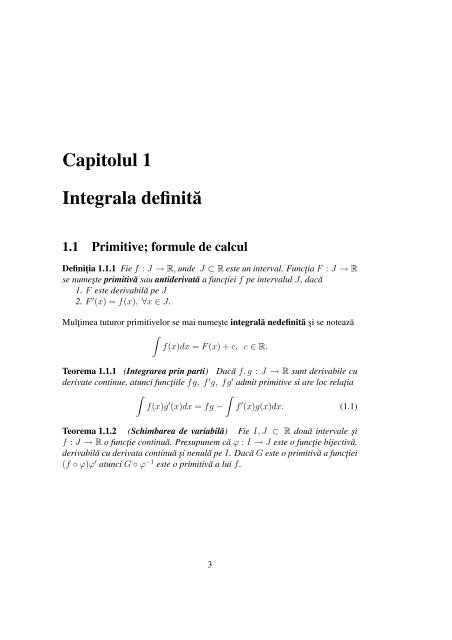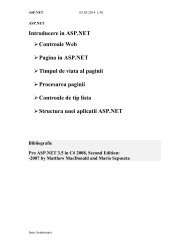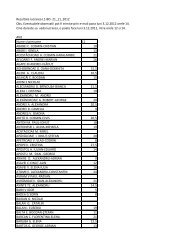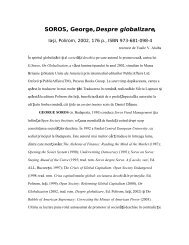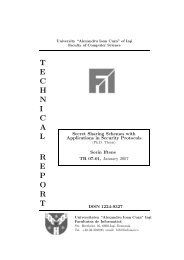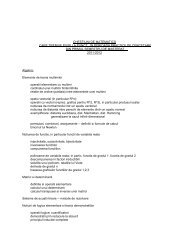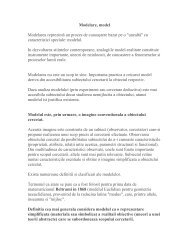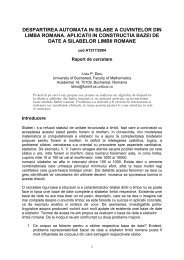Integrale si ecuatii diferentiale.pdf - Profs.info.uaic.ro
Integrale si ecuatii diferentiale.pdf - Profs.info.uaic.ro
Integrale si ecuatii diferentiale.pdf - Profs.info.uaic.ro
Create successful ePaper yourself
Turn your PDF publications into a flip-book with our unique Google optimized e-Paper software.
CITY COUNCIL 4.3bRESOLUTION NO. _______ (CM)A RESOLUTION OF THE CITY COUNCIL OF THE CITY OFWATSONVILLE REJECTING CLAIM OF MELISSA ORONA ACTINGON BEHALF OF CARESSA ORONA FOR DAMAGES(Date of Occurrence: October 1, 2012)BE IT RESOLVED BY THE CITY COUNCIL OF THE CITY OFWATSONVILLE, CALIFORNIA, AS FOLLOWS:That the claim of Melissa O<strong>ro</strong>na acting on behalf of Caressa O<strong>ro</strong>na fordamages, which was filed with the City Clerk on April 1, 2013, be and the same ishereby rejected.*******************************The foregoing resolution was int<strong>ro</strong>duced at a regular meeting of the Council ofthe City of Watsonville, held on the day of , 2013, by CouncilMemberby Council Member, who moved its adoption, which motion being duly seconded, was upon <strong>ro</strong>ll call carried and the resolutionadopted by the following vote:AYES:NOES:ABSENT:COUNCIL MEMBERS:COUNCIL MEMBERS:COUNCIL MEMBERS:ATTEST:______________________________Lowell Hurst, Mayor____________________________City ClerkAPPROVED AS TO FORM:____________________________City AttorneyReso No. (CM)Q:\COUNCIL\2013\042313\RC 13-14 O<strong>ro</strong>na.docxri 4/17/2013 11:19:29 AM1AJS ______ CJP ______
4 CAPITOLUL 1. INTEGRALA DEFINITĂTABELUL PRIMITIVELORNotăm prin F o primitivă a funcţiei f şi J ⊂ R un interval.f1 x n , x ∈ J ⊂ R, n ∈ NFx n+1n + 12 x a , x ∈ J ⊂ (0, +∞), a ∈ R \ {−1}x a+1a + 13 a x , x ∈ J ⊂ R, a ∈ R + \ {0, 1}a xln a451, x ∈ J, J ⊂ (−∞, 0) sau J ⊂ (0, +∞) ln |x|x∣ 1x 2 − a , x ∈ J ⊂ R \ {−a, a}, a ≠ 0 1 ∣∣∣ 2 2a ln x − ax + a∣6 f(x) =1x 2 + a , x ∈ J ⊂ R, a ≠ 0 12 a arctan x a7 <st<strong>ro</strong>ng>si</st<strong>ro</strong>ng>n x, x ∈ J ⊂ R − cos x8 cos x, x ∈ J ⊂ R <st<strong>ro</strong>ng>si</st<strong>ro</strong>ng>n x91cos 2 x , x ∈ J ⊂ R \ {(2k + 1)π }, k ∈ Z tan x2101<st<strong>ro</strong>ng>si</st<strong>ro</strong>ng>n 2 , x ∈ J ⊂ R \ {kπ}, k ∈ Z − cothx
1.2. INTEGRALA DEFINITĂ; APLICAŢII 767.72.76.81.85.1x 2 + 2x + 5 68. 1x 2 + 2x 69. 13x 2 − x + 1 70. (x − 1) 2x 2 + 3x + 4 71. 1√x − x21√ 73. 1√2 + 3x − 2x2 x2 + px + q 74. 3x − 6√x2 − 4x + 5 75. 2x − 8√ 1 − x − x621x √ 1 − x 77. 12 (x + a)(x + b) 78. x 2 − 5x + 9x 2 − 5x + 6 79. 1x(x + 1) 80. x 42 x 4 − 1x 4 − 6x 3 + 12x 2 + 6x 3 − 6x 2 + 12x − 8 82. 2x − 3(x 2 − 3x + 2) 3 83. 1x 3 + 1 84. 1x 4 + x 2 + 11(1 + x 2 ) 86. 12 (a 2 + x 2 ) 87. 3x + 52 (x 2 + 2x + 2) 288.13 + 5 cos x 89. 1<st<strong>ro</strong>ng>si</st<strong>ro</strong>ng>n x + cos x 90.cos x1 + cos x 91. 18 − 4 <st<strong>ro</strong>ng>si</st<strong>ro</strong>ng>n x + 7 cos x92. cos 3 x 93. <st<strong>ro</strong>ng>si</st<strong>ro</strong>ng>n 5 x 94. <st<strong>ro</strong>ng>si</st<strong>ro</strong>ng>n 2 x cos 3 x 95. <st<strong>ro</strong>ng>si</st<strong>ro</strong>ng>n 4 x 96. <st<strong>ro</strong>ng>si</st<strong>ro</strong>ng>n 2 x cos 2 x97. <st<strong>ro</strong>ng>si</st<strong>ro</strong>ng>n 3x cos 5x 98. <st<strong>ro</strong>ng>si</st<strong>ro</strong>ng>n 10x <st<strong>ro</strong>ng>si</st<strong>ro</strong>ng>n 15x 99. <st<strong>ro</strong>ng>si</st<strong>ro</strong>ng>n x 3 cos 2x 3 100. 1 + tan x1 − tan x101.1√ 2x − 1 −4 √ 2x − 1 102. x 3√ x − 1103.√1√ √ x +3x 104. 3 x + 1x − 1105.√1x − 1√ √ 106. xx + 1 + (x + 1)3 x + 1 107.3 √ 1 + 4√ x√ x108.14√1 + x4109. x 3 (1 + x 2 ) − 3 2 110.113.1√x3 3√ 1 + 4√ x 31x 4√ 1 + x 111. 12 x 3√ 1 + x 112. 15 x 2 (2 + x 3 ) 5 31.2 Integrala definită; aplicaţiiCon<st<strong>ro</strong>ng>si</st<strong>ro</strong>ng>derăm funcţia mărginităf : [a, b] → R,[a, b] ⊂ Rşi o diviziune ∆
8 CAPITOLUL 1. INTEGRALA DEFINITĂcu norma diviziunii∆ = {x 0 , x 1 , . . . , x n }, a = x 0 < x 1 < . . . < x n = b‖∆‖ = max1in (x i − x i−1 )şi pentru orice i ∈ {1, n} punctele intermediare ξ i ∈ (x i−1 , x i ) suma Riemannσ ∆ =n∑f(ξ i )(x i − x i−1 ).i=1Definiţia 1.2.1 Numim integrală Riemann sau definită numărul I cu p<strong>ro</strong>prietateacă ∀ε > 0, ∃η ε astfel ca pentru orice diviziune ∆ cu ‖∆‖ < η ε şi pentru oricealegere a punctelor intermediare are loc|σ ∆ − I| < εFuncţia f se numeşte integrabilă Riemann.Numărul I este unic determinat şi se noteazăPrin definiţie∫ bI =∫ aa∫ baf(x)dxf(x)dx = 0f(x)dx = −∫ aabf(x)dxSume DarbouxNotămFie f : [a, b] → R o funcţie mărginită şi ∆ o diviziune oarecare.m i =inf f(x), M i = sup f(x)x∈[x i−1 ,x i ] x∈[x i−1 ,x i ]Şi con<st<strong>ro</strong>ng>si</st<strong>ro</strong>ng>derăm sumele Darbouxn∑s ∆ = m i (x i − x i−1 ), S ∆ =i=1n∑M i (x i − x i−1 ).Teorema 1.2.1 Fie f : [a, b] → R o funcţie mărginită. Următoarele afirmaţiisunt echivalente:1. ∀ε > 0, ∃η ε astfel ca pentru orice diviziune ∆ cu ‖∆‖ < η εi=12. funcţa f este integrabilă.S ∆ − s ∆ < ε (1.2)
1.2. INTEGRALA DEFINITĂ; APLICAŢII 9Teorema 1.2.2 Dacă f : [a, b] → R este o funcţie integrabilă Riemann peintervalul [a, b] şi f(x) 0, ∀x ∈ [a, b] atunci∫ baf(x)dx 0.Consecinţa 1 Dacă f, g : [a, b] → R sunt funcţii integrabile Riemann astfel caf(x) g(x), ∀x ∈ [a, b]atunci are locConsecinţa 2∫ bf(x)dx ∫ baag(x)dx.Dacă f : [a, b] → R este o funcţie integrabilă şim f(x) M, ∀x ∈ [a, b]atuncim(b − a) ∫ baf(x)dx M(b − a).Teorema 1.2.3 (Leibniz Newton) Fie f : [a, b] → R o funcţie integrabilă şicare admite primitive. Atunci pentru orice primitivă F are locVom folo<st<strong>ro</strong>ng>si</st<strong>ro</strong>ng> notaţia F (x)| b a.∫ baf(x)dx = F (b) − F (a).Teorema 1.2.4 (Integrarea funcţiilor continue)continuă este integrabilă.Orice funcţie f : [a, b] → RTeorema 1.2.5 (Teoremă de medie) Dacă este o funcţie continuă, atunci existăξ ∈ [a, b] astfel ca1b − a∫ baf(x)dx = f(ξ).
10 CAPITOLUL 1. INTEGRALA DEFINITĂTeorema 1.2.6 (Existenţa primitivelor unei funcţii continue) Dacă f : [a, b] →R este o funcţie continuă, funcţia F : [a, b] → R definită prinF (x) =∫ xeste o primitivă care se anulează în punctul a.af(t)dt, ∀x ∈ [a, b] (1.3)Teorema 1.2.7 (Formula de integrare prin părţi)funcţii derivabile, cu derivate continue, atunciDacă f, g : [a, b] → R sunt∫ baf(x)g ′ (x)dx = f(x)g(x)| b a −∫ bag(x)f ′ (x)dx. (1.4)Teorema 1.2.8 (Schimbarea de variabilă) Fie u : [a, b] → [c, d] o funcţie cup<strong>ro</strong>prietăţile: u bijectivă, u şi u −1 sunt derivabile, cu derivate continue.Fie f : [c, d] → R o funcţie continuă.Atunci are loc formula∫ baf(u(t))dt =∫ u(b)u(a)f(x)(u −1 ) ′ (x)dx. (1.5)Aplicaţii ale integralei definiteTeorema 1.2.9 (Aria unei suprafeţe plane) Dacă f : [a, b] → R + este continuăatunci mulţimeaD = {(x, y) ∈ R 2 | a x b, 0 y f(x)}are arie şiaria(D) =∫ baf(x)dx. (1.6)Teorema 1.2.10 (Volumul unui corp de <strong>ro</strong>taţie) Dacă f : [a, b] → R + estecontinuă atunci corpul de <strong>ro</strong>taţie determinat de f, adică mulţimeaare volum dat de formulaV = {(x, y, z) ∈ R 3 | √ y 2 + z 2 r, a x b}vol(V ) = π∫ baf 2 (x)dx (1.7)
1.2. INTEGRALA DEFINITĂ; APLICAŢII 11Teorema 1.2.11 (Lungimea unui arc de curbă ) Dacă f : [a, b] → R + este ofuncţie derivabilă cu derivata continuă atunci1. graficul lui f are lungime finită2. lungimea este dată del =∫ ba√1 + (f′(x)) 2 dx (1.8)Teorema 1.2.12 (Aria unei suprafete de <strong>ro</strong>taţie) Dacă f : [a, b] → R + este ofuncţie derivabilă cu derivata continuă atunci suprafaţa de <strong>ro</strong>taţie determinată def, adică mulţimeaare arie dată deS = {(x, y, z) ∈ R 3 | √ y 2 + z 2 = f(x), a x b}aria(S) = 2π∫ baf(x) √ 1 + (f ′ (x)) 2 dx (1.9)I. Determinaţi∫semnul următoarelor integrale10 ∫ π<st<strong>ro</strong>ng>si</st<strong>ro</strong>ng>n x1. e x2 dx 2.x0π2II. Determinaţi∫cea mai mare dintre integrale (fără a face calculul lor)1 √∫ 11. 1 + x2 dx şi xdx2.3.∫01∫020x 2 <st<strong>ro</strong>ng>si</st<strong>ro</strong>ng>n 2 xdxe x2 dxπ4şişi∫ 21∫010e x dxx <st<strong>ro</strong>ng>si</st<strong>ro</strong>ng>n 2 xdx4. Arătaţi că are loc inegalităţilea. 2 ∫ 13 < dx√ < √ 10 2 + x − x2 2b. 1 ∫ π √2 < 2 <st<strong>ro</strong>ng>si</st<strong>ro</strong>ng>n x 2x < 25. Calculaţi limitele următoarelor şiruria. a n = 3 ( √ √√)n n1 +n n + 3 + n + 6 . . . + nn + 3(n − 1)b. a n = π (<st<strong>ro</strong>ng>si</st<strong>ro</strong>ng>n π n n + <st<strong>ro</strong>ng>si</st<strong>ro</strong>ng>n 2π )(n − 1)π+ . . . + <st<strong>ro</strong>ng>si</st<strong>ro</strong>ng>nn 2n
12 CAPITOLUL 1. INTEGRALA DEFINITĂ6. Fie f : [−a, a] → R o funcţie continuă. Arătaţi ca are loc∫ a{ ∫ a2 f(x)dx dacă f este parăf(x)dx = 00 dacă f este impară−a7. Fie f : [a, b] → R o funcţie continuă. Arătaţi că are loc∫ bf(x)dx =∫ baaf(a + b − x)dx8. Stabiliţi egalitatea∫ 10arctan xdx = 1 ∫ π2x 2 0t<st<strong>ro</strong>ng>si</st<strong>ro</strong>ng>n t dt9. Determinaţi punctul ξ ∈ [1, 3] astfel ca funcţia f(x) = x 2 , x ∈ [1, 3] săsatisfacă ∫ 3f(x)dx = 2f(ξ).110. Rezolvaţi ecuaţia ∫ xdt√2 t √ t 2 − 1 = π 1211. Calculaţi următoarele arii:a. aria elipseib. aria delimitată de y = 4x − x 2 şi de abscisăc. aria delimitaă de ln x şi x = e.12. Calculaţi { lungimile următoarelor curbex = a(t − <st<strong>ro</strong>ng>si</st<strong>ro</strong>ng>n t)a., t ∈ [0, 2π] (cicloida)y = a(1 − cos t)b. x 2 3 + y 2 3 = a 2 31.3 Integrala curbilinieFie f : D → R o funcţie continuă unde D ⊂ R n cu n = 2, 3.Fie γ o curbă inclusă în D care este netedă de forma⎧⎨ x = x(t)(γ) y = y(t) , t ∈ [a, b] ⊂ R (1.10)⎩z = z(t)
1.3. INTEGRALA CURBILINIE 13unde x, y, z sunt funcţii derivabile cu derivata continuă pe [a, b].Definiţia 1.3.1 Numim integrală curbilinie de prima speţă a funcţiei f∫∫f(x, y, z)ds = f(x(t), y(t), z(t)) √ (x ′ ) 2 (t) + (y ′ ) 2 (t) + (z ′ ) 2 (t)dtγ(1.11)unde ds = √ (x ′ ) 2 (t) + (y ′ ) 2 (t) + (z ′ ) 2 (t) este elementul de arc.Observaţii 1. Integrala este independentă de sensul de parcurs pe curbă.2. Dacă γ este o curbă plană atunci în ecuaţiile (1.10) vom lua z = 0.Aplicaţii 1. Masa unei curbe netede γ. Presupunem că în fiecare punct alcurbei, masa este o funcţie continuă f(x, y, z), atunci masa curbei este∫M = f(x, y, z)ds. (1.12)γ2. Momentele statice ale unei curbe în raport cu axele de coordonate sunt date deformuleleM x = ∫ xf(x, y, z)dsγM y = ∫ yf(x, y, z)dsγ(1.13)M z = ∫ zf(x, y, z)ds γCoordonatele centrului de greutate suntx C = M xMy C = M yMIntegrala curbilinie (IC) de speţa a douaz C = M zM(1.14)Fie γ o curbă inclusă în D care este netedă, dată ca în (1.10).Fie funcţiile reale de variabile realeP, Q, R : D → R, D ⊂ R 3care sunt continue. Presupunem că γ ⊂ D.Definiţia 1.3.2=Numim intgrala curbilinie de speţa a doua∫P (x, y, z)dx + Q(x, y, z)dy + R(x, y, z)dz =γ∫ ba(P (x(t), y(t), z(t))x ′ (t) + Q(x(t), y(t), z(t))y ′ (t)++R(x(t), y(t), z(t))z ′ (t))dt (1.15)
14 CAPITOLUL 1. INTEGRALA DEFINITĂTeorema 1.3.1 Aria unei multimi plane mărginite de o curbă netedă <st<strong>ro</strong>ng>si</st<strong>ro</strong>ng>mplă estearia(D) = 1 ∫xdy − ydx (1.16)2Teorema 1.3.2 În ipotezele anterioare următoarele afirmaţii sunt echivalente1. IC este independentă de drum2. pentru orice curbă C închisă şi <st<strong>ro</strong>ng>si</st<strong>ro</strong>ng>mplă are loc∮P (x, y)dx + Q(x, y)dy = 0 (1.17)CDefiniţia 1.3.3 Presupunem că există o funcţie F : D → R, D ⊂ R 2 cu derivateparţiale de ordinul întâi continue, astfel caγ∂F∂F(x, y) = P (x, y),∂x(x, y) = Q(x, y), ∀(x, y) ∈ D.∂yExpre<st<strong>ro</strong>ng>si</st<strong>ro</strong>ng>a P (x, y)dx + Q(x, y)dy se numeşte diferenţială totală exactă. Funcţia Fse numeşte primitiva expre<st<strong>ro</strong>ng>si</st<strong>ro</strong>ng>ei P dx + Qdy.Teorema 1.3.3 Presupunem că există o funcţie F : D → R cu derivate parţialecontinue astfel încât∂F∂F(x, y) = P (x, y),∂x(x, y) = Q(x, y), ∀(x, y) ∈ D.∂yAtunci are loc∫P (x, y)dx + Q(x, y)dy = F (x(b), y(b)) − F (x(a), y(a)). (1.18)γÎn particular integrala rezultă independentă de drum.∫Teorema 1.3.4 Dacă integrala P (x, y)dx + Q(x, y)dy este independentă dedrum, atunci funcţia F : D → R, D ⊂ R 2 definită prinF (x, y) =γ∫ (x,y)(x 0 ,y 0 )P (x, y)dx + Q(x, y)dy (1.19)pe orice curbă netedă cu extremităţile (x 0 , y 0 ), (x, y) ∈ D satisface∂F∂F(x, y) = P (x, y),∂x(x, y) = Q(x, y).∂y
1.3. INTEGRALA CURBILINIE 15Teorema 1.3.5 Dacă domeniul D ⊂ R 2 este <st<strong>ro</strong>ng>si</st<strong>ro</strong>ng>mplu conex ( fără ” goluri”)umătoarele ∫ afirmaţii sunt echivalente:1. P (x, y)dx + Q(x, y)dy este independentă de drumγ2. ∂P∂y = ∂Q , ∀(x, y) ∈ D.∂xI. Calculaţi următoarele integrale de speţa întâi∫1. (x 2 + 1)ds, unde (γ) este conturul triunghiului OAB, cu O(0, 0), A(1, 0), B(0, 1)2.3.4.5.6.7.8.∫∫∫∫∫∫∫γγγγγγγγxyds, (γ) : {(x, y) | |x| + |y| = a}ds√ dx, (γ) : este dreapta de extremităţi O(0, 0), A(1, 2)x2 + y 2 + 4xyds,(γ) : conturul elipsei <st<strong>ro</strong>ng>si</st<strong>ro</strong>ng>tuat în primul cadranyds, (γ) : {(x, y) | y 2 = 2px, x ∈ [0, x 0 ]}(x 2 + y 2 )ds, (γ) : este dreapta de extremităţi A(a, a), B(b, b)ye −x ds, (γ) :xyzds, (γ) :{ x = ln(1 + t 2 )y = 2 arctan t − t + 3⎧⎨⎩x = ty = 1 3√8t3z = 1 2 t2 t ∈ [0, 1]t ∈ [0, 1]II. Calculaţi următoarele integrale de speţa a doua pe drumurile indicate∫1. 2xydx + x 2 dy, unde AB, A(0, 0), B(1, 1) esteABa. segmentul de dreaptăb. arcul de pe parabola y 2 = xc. arcul de pe parabola y = x 2d. arcul de pe parabola cubică y = x 3
16 CAPITOLUL 1. INTEGRALA DEFINITĂ2.3.∫∫ABγ(x − y 2 )dx + 2xydy, unde γ este curba de extremităţi O(0, 0), B(1, 1) indicatăxydx + (y − x)dy pe aceleaşi drumuri ca mai inaintea. segmentul de extremităţi OAb. curba OMA unde M este p<strong>ro</strong>iecţia lui A pe axa Oxc. curba ONA unde N este p<strong>ro</strong>iecţia lui A pe axa Oy∫4. Aceeşi p<strong>ro</strong>blemă pentru (2xy + y 2 )dx + (2xy + x 2 )dy,5.∫γγ(x 2 + 2xy)dy pe conturul elipsei, <st<strong>ro</strong>ng>si</st<strong>ro</strong>ng>tuat în semiplanul superior, parcurs însens trigonometric.∫x 2 dy − y 2 dx6.unde γ este conturul ast<strong>ro</strong>idei, curba cu o reprezentare parametricăde formaγ x 5 3 + y 5 3{ x = a <st<strong>ro</strong>ng>si</st<strong>ro</strong>ng>n 3 ty = a cos 3 t ∈ [0, 2π]t∫7. Este integrala (x 2 + y 2 )(xdx + ydy) egală cu 0 pe orice contur închis ? Dar∫γxdx + ydy?γ x 2 + y 2 ∫8. Depinde integrala (xdy − ydx) de drumul de integrare ?γ9. Stabiliţi existenţa funcţiei primitive şi gă<st<strong>ro</strong>ng>si</st<strong>ro</strong>ng>ţi acestă funcţie în următoarelecazuri:a. (4x 3 y 3 − 3y 2 + 5)dx + (3x 4 y 2 − 6xy − 4)dyb. (10xy − 8y)dx + (5x 2 − 8x + 3)dyc. (4x 3 y 3 − 2y 2 )dx + (3x 4 y 2 − 2xy)dyd. ((x + y + 1)e x − e y )dx + (e x − (x + y + 1)e y )dy10. Determinaţi o condiţie echivalentă cu faptul că F (x, y)(xdx + ydy), undeF : D → R, D ⊂ R 2 , domeniu <st<strong>ro</strong>ng>si</st<strong>ro</strong>ng>mplu conex, este o diferenţială totală exactă.1.4 Integrala imp<strong>ro</strong>prie<st<strong>ro</strong>ng>Integrale</st<strong>ro</strong>ng> imp<strong>ro</strong>prii pe interval nemărginitFie f : [a, +∞) → R, a ∈ R.
1.4. INTEGRALA IMPROPRIE 17Definiţia 1.4.1 f se numeşte integrabilă pe [a, +∞) dacă1. f este integrabilă pe intervalul [a, b], ∀b ∈ R2. există şi este finită limita lim∫ +∞ab→+∞∫ baf(x)dx = limb→+∞f(x)dx. Vom nota∫ bVom spune în acest caz că integrala este convergentă şi vom notaiar în caz contrar că este divergentă.af(x)dx. (1.20)∫ ∞af(x)dx < +∞,Definiţia 1.4.2 Funcţia f : [a, +∞) → R, a ∈ R se numeşte absolut integrabilăpe [a, +∞) dacăIntegrala∫ +∞a∫ +∞a| f(x) | dx < +∞.f(x)dx se numeşte absolut convergentă.Analog se pot defini noţiunile de integrabilitate pe intervale de forma (−∞, b],unde b ∈ R sau (−∞, +∞). Menţionăm că în acest al doilea caz, alegem c ∈ Rşi reducem la <st<strong>ro</strong>ng>si</st<strong>ro</strong>ng>tuaţiile precedente, dacă realizăm desfacerea∫ ∞−∞f(x)dx =Există <st<strong>ro</strong>ng>si</st<strong>ro</strong>ng>tuaţii când integrala∫ ∞−∞∫ c−∞f(x)dx +∫ +∞este finită limita următoare, numită valoare principalăvp∫ ∞−∞cf(x)dx.f(x)dx nu este convergentă şi totuşi există şif(x)dx =∫ alima→+∞−af(x)dx (1.21)Teorema 1.4.1 (Teoremă de caracterizare) Integralaşi numai dacă ∀ε > 0, ∃b ε astfel încât ∀ b ′ , b ′′ b ε are loc∫ b ′′∫ +∞af(x)dx < +∞ dacă| f(x)dx |< ε. (1.22)b ′Teorema 1.4.2 Dacă f : [a, +∞) → R, a ∈ R este absolut integrabilă atuncieste şi integrabilă.
18 CAPITOLUL 1. INTEGRALA DEFINITĂTeorema 1.4.3 (Criteriul de comparaţie) Fie integralele∫ +∞ag(x)dx.1. Presupunem că sunt îndeplinite condiţiileatunci rezultă că integrala∫ +∞a∫ +∞af(x)dx şig(x)dx este convergentă (1.23)| f(x) | g(x), x x 1 , x 1 ∈ R (1.24)∫ +∞af(x)dx este absolut convergentă.2. Dacă ∫ +∞f(x)dx este divergentă (1.25)rezultă că integrala∫ +∞aa0 f(x) g(x), x x 2 , x 2 ∈ R (1.26)g(x)dx este divergentă.Teorema 1.4.4 (Criteriul cu limită) 1. Dacăatunciatunci∫ +∞a2. Dacă∫ +∞alim | f(x) |x→+∞ xα < +∞ şi α > 1 (1.27)f(x)dx este absolut convergentă.f(x)dx este divergentă.limx→+∞ f(x)xα > 0 şi α 1 (1.28)<st<strong>ro</strong>ng>Integrale</st<strong>ro</strong>ng> imp<strong>ro</strong>prii de funcţii nemărginiteFie f : [a, b) → R, a, b ∈ R o funcţie nemărginită în b.Definiţia 1.4.3 Funcţia f se numeşte integrabilă pe [a, b), dacă1. f este integrabilă pe orice interval ([a, b − ε]), ∀ε > 02. există şi este finită limita lim∫ baε→0∫ b−εaf(x)dx = limf(x)dx. Vom notaε→0∫ b−εaf(x)dx. (1.29)
1.4. INTEGRALA IMPROPRIE 19Integrala se numeşte convergentă şi vom nota ∫ bf(x)dx < +∞ iar în caz contrar,adivergentă.Definiţia 1.4.4pe [a, b) dacăFuncţia f : [a, b) → R, a, b ∈ R se numeşte absolut integrabilă∫ ba| f(x) | dx < +∞. (1.30)Analog se poate defini integrabilitatea pentru funcţii definite pe (a, b], nemărginiteîn a. Dacă f : [a, b] → R şi f nu este mărginită într-un punct interior intervaluluic, studiul convergenţei se poate reduce la cazurile precedente, desfăcând integrala∫ baf(x)dx =∫ caf(x)dx +∫ bcf(x)dx.Pentru ultima <st<strong>ro</strong>ng>si</st<strong>ro</strong>ng>tuaţie se defineşte de asemenea noţiunea de valoare principalăprin următoarea limită (dacă există şi este finită)vp∫ baf(x)dx = limε→0(∫ c−εaf(x)dx +∫ bc+ε)f(x)dx(1.31)Teorema 1.4.5 (Teoremă de caracterizare) Integrala ∫ bf(x)dx este convergentădacă şi numai dacă ∀ε > 0 există δ > 0 astfel ca oricare ar fi t ′ , t ′′ ∈ [a, b),acu 0 < b − t ′ < δ, 0 < b − t ′′ < δ are loc|∫ t ′′t ′ f(x)dx |< ε. (1.32)Teorema 1.4.6 Dacă funcţia f este absolut integrabilă pe [a, b) atunci ea esteintegrabilă pe [a, b).Teorema 1.4.7 (Criteriu de comparaţie) Fie integralele ∫ bf(x) şi ∫ bg(x)dx.a aDacă ∫ +∞g(x)dx este convergentă (1.33)rezultă căDacă∫ baa| f(x) | g(x), x ∈ [c 1 , b), c 1 a (1.34)f(x)dx este absolut convergentă.∫ baf(x)dx este divergentă (1.35)
20 CAPITOLUL 1. INTEGRALA DEFINITĂrezultă∫ ba0 f(x) g(x), x ∈ [c 2 , b), c 2 a (1.36)g(x)dx este divergentă.Teorema 1.4.8 (Criteriul cu limită) 1. Dacăatunciatunci∫ ba2. Dacă∫ balim | f(x) | (b −x→b,x o, a > 06.0dx1 + x 4∫ +∞19.0∫ +∞0dx2x + (x 2 + 1) 1 3 + 5x 5 21 + x dx 2∫ +∞(e − a2x 2− e − b2x 2 )dx
1.5. INTEGRALA CU PARAMETRU 21III.1.5.9.Studiaţi convergenţa următoarelor integrale∫ 30∫ 120∫ 10∫ 1dx2.(x − 1) 2 0∫dx2x ln x 6.arc<st<strong>ro</strong>ng>si</st<strong>ro</strong>ng>n x√1 − x210.∫dx1√ 3. 1 − x2dx√| x |7.−1∫ ba0∫ 21∫xdx1√ 4. 1 − x4∫dx1ln x 8.xdx√(x − a)(x − b)11.−1∫ ∞00dx√ xdx3√1 − x2x ln x(1 − x 2 ) 2 dx1.5 Integrala cu parametruDacă f : [a, b] × R → R este o funcţie cu p<strong>ro</strong>prietatea că pentru orice y ∈ R,există integralaF (y) =∫ baf(x, y)dx (1.39)Teorema 1.5.1 (Continuitatea integralei cu parametru) Dacă f : [a, b]×R →R este uniform continuă, atunci funcţia F este continuă.Teorema 1.5.2 (Derivabilitatea integralei cu parametru) Dacă f : [a, b] ×[c, d] → R şi au loc:i. ∀y ∈ [c, d] există integrala cu parametru F (y) =ii. există ∂f continuă pe [a, b] × [c, d]∂yatunci F este derivabilă şiF ′ (y) =∫ ba∫ baf(x, y)dx;∂f(x, y)dx. (1.40)∂yTeorema 1.5.3 (Teorema lui Leibniz) Fie integrala cu parametruF (y) =∫ β(y)α(y)şi presupunem îndeplinite următoarele ipotezef(x, y)dx, y ∈ [c, d]i. funcţiile α, β : [c, d] → [a, b] sunt derivabile,ii. f : [a, b] × [c, d] → R este o funcţie continuă,
22 CAPITOLUL 1. INTEGRALA DEFINITĂiii. există ∂f∂y: [a, b] × [c, d] → R, continuăatunci F este derivabilă şi are loc formulaF ′ (y) = f(β(y), y)β ′ (y) − f(α(y), y)α ′ (y) +∫ β(y)α(y)∂f(x, y)dx. (1.41)∂yTeorema 1.5.4 (Integrarea unei integrale cu parametru) Fie f : [a, b] ×[c, d] → R o funcţie continuă, atunci are loc formula∫ dc(∫ ba)f(x, y)dx dy =Con<st<strong>ro</strong>ng>si</st<strong>ro</strong>ng>derăm integralele cu parametruşiΓ(p) =B(p, q) =∫ +∞0∫ 1pe care le numim integralele lui Euler.0∫ ba(∫ dc)f(x, y)dy dx. (1.42)x p−1 e −x dx (1.43)x p−1 (1 − x) q−1 dx. (1.44)Teorema 1.5.5 (Convergenţa integralelor lui Euler) <st<strong>ro</strong>ng>Integrale</st<strong>ro</strong>ng>le imp<strong>ro</strong>prii cuparametru (1.43) şi (1.44) sunt convergente pentru p > 0, respectiv p, q > 0.Teorema 1.5.6 ( Formule de calcul)p<strong>ro</strong>prietăţi<st<strong>ro</strong>ng>Integrale</st<strong>ro</strong>ng>le lui Euler satisfac următoareleΓ(1) = 1 (1.45)Γ(p + 1) = pΓ(p) (1.46)B(p, q) = B(q, p) (1.47)Co<strong>ro</strong>larul 1.5.1 Din (1.46) deducemB( 1 2 , 1 2 ) = π (1.48)Γ(n + 1) = n! (1.49)Γ(n + 1 (2n − 1) . . . 31) = Γ( 1 2 2 n 2 ) (1.50)
1.5. INTEGRALA CU PARAMETRU 23Teorema 1.5.7 (Legătura dintre Gamma şi Beta) Are loc următoarea formulăCo<strong>ro</strong>larul 1.5.2 Următoarele afirmatii sunt adevărateB(p, q) = Γ(p)Γ(q)Γ(p + q) . (1.51)Γ( 1 2 ) = √ π (1.52)∫ +∞Teorema 1.5.8 (Formula lui Gauss)0e −x2 dx =√ π2(1.53)Γ(p) =limn→+∞n!n pp(p + 1) . . . (p + n)(1.54)Teorema 1.5.9 (Formula complementelor )Γ(p)Γ(p + 1) =Dacă p ∈ (0, 1) atunci are locπ<st<strong>ro</strong>ng>si</st<strong>ro</strong>ng>n πp(1.55)I. Calculaţi următoarele integrale folo<st<strong>ro</strong>ng>si</st<strong>ro</strong>ng>nd derivarea integralei cu parametru.1. F (y) =2. F (y) =3. F (y) =4. F (y) =5. F (y) =6. F (a, b) =7. F (a, b) =∫ π20∫ ∞0∫ b0∫ b0∫ π2ln(y 2 − <st<strong>ro</strong>ng>si</st<strong>ro</strong>ng>n 2 x)dx, y > 1arctan xyx(1 + x 2 ) dxx(1 + xy) 2 dx, b > 0dx(x 2 + y 2 ) 30∫ π20∫ ∞01cos x1 + y cos xln dx, y ∈ (−1, 1)1 − y cos xdx(a 2 cos 2 x + b 2 <st<strong>ro</strong>ng>si</st<strong>ro</strong>ng>n 2 x) 2e −ax2 − e −bx2dx, a > 0, b > 0x
24 CAPITOLUL 1. INTEGRALA DEFINITĂ8. F (a, b) =∫ ∞0e −ax − e −bx<st<strong>ro</strong>ng>si</st<strong>ro</strong>ng>n mx dxxII.Calculaţi schimbând ordinea de integrare1.2.∫ ∞e −axx0∫ ∞e −ax0 x(cos bx − cos cx)dx, a > 0, b, c ∈ R(<st<strong>ro</strong>ng>si</st<strong>ro</strong>ng>n bx − <st<strong>ro</strong>ng>si</st<strong>ro</strong>ng>n cx)dx, a > 0, b, c ∈ RIII.Arătaţi că următoarele egalităţi au loc1. B(p, q) =∫ +∞02 B(p, 1 − p) =∫ +∞0y p−1(1 + y)p+qdyy p−11 + y dy, 0 < p < 13. B(p, q) = q − 1p − 1B(p, q − 1) = B(p − 1, q) p > 1, q > 1p + q − 1 p + q − 1IV. Reduceţi la integralele lui Euler şi stabiliţi natura lor:1.2.3.4.5.6.7.∫ π20∫ 10∫ +∞0∫ +∞0∫ +∞0∫ +∞0∫ +∞0<st<strong>ro</strong>ng>si</st<strong>ro</strong>ng>n m x cos n xdx, m, n ∈ Rdx, m > 0, n ∈ N(1 − x m ) 1 nx m−1dx m, n ∈ R(1 + x)nx p e −ax dx, a > 0, p ∈ Rx 1 4(1 + x) 2 dxx m−1dx, m, n ∈ R1 + xn x 2n e −x2 dx, n ∈ N.
Capitolul 2Ecuaţii diferenţiale2.1 Ecuaţia diferenţială de ordinul 1Forma generală e unei ecuaţii diferenţiale ordinare de ordinul 1 estey ′ (x) = f(x, y) (2.1)x ∈ (a, b) este funcţia necunos-unde x este variabila independentă, y = y(x),cută, y ′ (x) = dy este derivata, iar f : D → R,dx D⊂ R2 este o funcţie continuă.Definiţia 2.1.1 Numim soluţie a ecuaţei (2.1) funcţia y : (a, b) → R, y = y(x)derivabilă pe (a, b) care verifică identic ecuaţia (2.1), adicăy ′ (x) = f(x, y(x)), x ∈ (a, b).Interpretare geometrică Soluţia este o curbă în planul x0y, având în fiecarepunct tangentă care variază continuu in raport cu punctul. Curba se numeştecurbă integrală şi poate fi dată cartezian explicit, adică y = y(x) sau cartezianimplicit adică F (x, y) = C. Mulţimea tutu<strong>ro</strong>r curbelor soluţie se numeşte soluţiegenerală.Numim p<strong>ro</strong>blemă Cauchy determinarea unei soluţii a ecuaţiei (2.1) care satisface ocondiţie de forma (??). Geometric, aceasta revine la determinarea unei curbe integralecare să teacă printr-un punct dat (x 0 , y 0 ). Vom stabili o teoremă de existenţăşi unicitate , în anumite ipoteze asupra lui f a soluţiei p<strong>ro</strong>blemei Cauchy, pe ovecinătate în jurul lui x 0 .1. Ecuaţii de forma y ′ (x) = f(x)25
26 CAPITOLUL 2. ECUAŢII DIFERENŢIALECon<st<strong>ro</strong>ng>si</st<strong>ro</strong>ng>derăm p<strong>ro</strong>blema Cauchy de forma{ y ′ (x) = f(x)y(x 0 ) = y 0(2.2)unde x ∈ (a, b) şi f este o funcţie continuă pe (a, b). Soluţia p<strong>ro</strong>blemei Cauchyeste de formay(x) = y 0 +2. Ecuaţii cu variabile separabile∫ xx 0f(t)dt. (2.3)Con<st<strong>ro</strong>ng>si</st<strong>ro</strong>ng>derăm p<strong>ro</strong>blema Cauchy de forma{ y ′ (x) = f(x)g(y)y(x 0 ) = y 0(2.4)unde x ∈ (a, b) şi f este o funcţie continuă pe (a, b) iar g este o funcţie continuăşi nenulă pe (c, d).Soluţia p<strong>ro</strong>blemei Cauchy este de formay(x) = G −1 (unde G −1 este inversa funcţiei G(y) = ∫ yy 0∫ xx 0f(t)dt). (2.5)dtdt. g(t)ExempluSă rezolvăm ecuaţiaSeparăm variabilele şi gă<st<strong>ro</strong>ng>si</st<strong>ro</strong>ng>m{y ′ (x) = x2 y 21+x 2y(0) = 1Prin integrare obţinem− 1 ydyy = x2 dx2 1 + x . 2= x − arctan x + c.Punând condiţia Cauchy y(0) = 1 gă<st<strong>ro</strong>ng>si</st<strong>ro</strong>ng>m c = −1 şi soluţia estey(x) =1arctan x − x + 1 .
2.1. ECUAŢIA DIFERENŢIALĂ DE ORDINUL 1 273. Ecuaţia omogenăCon<st<strong>ro</strong>ng>si</st<strong>ro</strong>ng>derăm ecuaţiay ′ (x) = h( y x ) (2.6)unde h este o funcţie continuă pe un interval (c, d). facem schimbarea de funcţieyx = u(x)şi prin derivare gă<st<strong>ro</strong>ng>si</st<strong>ro</strong>ng>m y ′ = u(x)+xu ′ (x), de unde dacă înlocuim în ecuaţie gă<st<strong>ro</strong>ng>si</st<strong>ro</strong>ng>mxu ′ (x) = h(u) − ucare este o ecuaţie cu variabile separabile.ExempluSă rezolvăm ecuaţay ′ =Observăm că poate fi pusă sub formaPrin substituţia y = xu(x) gă<st<strong>ro</strong>ng>si</st<strong>ro</strong>ng>my ′ =u + xxu ′ =xyx 2 − y 2 .yx1 − ( y x )2 .şi ajungem la ecuaţia cu variabile separabileu1 − u 2Prin rezolvarea ei gă<st<strong>ro</strong>ng>si</st<strong>ro</strong>ng>m curbelexu ′ =u31 − u 2 .ln | cy |= − x22y 2 .4. Ecuaţii reductibile la cazul omogenCon<st<strong>ro</strong>ng>si</st<strong>ro</strong>ng>derăm ecuaţiay ′ =ax + by + ca 1 x + b 1 y + c 1(2.7)
28 CAPITOLUL 2. ECUAŢII DIFERENŢIALEunde a, b, c, a 1 , b 1 , c 1 ∈ R. Dacă c = c 1 = 0 atunci ecuaţia este omogenă. Dacăcel puţin c sau c 1 este diferit de 0, atunci facem schimbarea de variabile{ x = x1 + h(2.8)y = y 1 + kSe obţine imediaty ′ =ax 1 + by 1 + ah + bk + ca 1 x 1 + b 1 y 1 + a 1 h + b 1 k + c 1.Cazul I Presupunem că ∣ ∣∣∣ a ba 1 b 1∣ ∣∣∣≠ 0. (2.9)Atunci <st<strong>ro</strong>ng>si</st<strong>ro</strong>ng>stemul { ah + bk + c = 0a 1 h + b 1 k + c 1 = 0are soluţie unică. Alegând h, k soluţii ale acestui <st<strong>ro</strong>ng>si</st<strong>ro</strong>ng>stem şi făcând schimbarea(2.8) obţinem ecuaţia omogenăy ′ 1 = ax 1 + by 1a 1 x 1 + b 1 y 1. (2.10)Cazul II Presupunem că ∣ ∣∣∣ a ba 1 b 1∣ ∣∣∣= 0. (2.11)Atunciaa 1= b b 1= 1 λ .Alegând a 1 = λa, b 1 = λb obţinem ecuaţiay ′ =ax + by + c(2.12)λ(ax + by) + c 1şi făcând substituţia z = ax + by obţinem ecuaţia cu variabile separabilez ′ − ab= z + cλz + c 1.5. Ecuaţii cu diferenţială totală exactă
2.1. ECUAŢIA DIFERENŢIALĂ DE ORDINUL 1 29Fie ecuaţiaP (x, y)dx + Q(x, y)dy = 0 (2.13)unde P, Q : D → R, D ⊂ R 2 sunt funcţii continue. Presupunem că P dx + Qdyeste diferenţială totală exactă. Atunci există o funcţie de clasă C 1 (D) astfel cadF (x, y) = P (x, y)dx + Q(x, y)dy = 0. Atunci soluţia generală esteMetoda factorului integrantF (x, y) = C, C ∈ R. (2.14)Dacă P dx + Qdy nu este diferentială totală exactă şi presupunem că suntem peun domeniu <st<strong>ro</strong>ng>si</st<strong>ro</strong>ng>mplu conex, înmulţim ecuaţia cu funcţia µ ; ecuaţia devineşi punem condiţia caµP (x, y)dx + µQ(x, y)dy = 0.Deducem ecuaţia∂(µP )∂y= ∂(µQ)∂x .∂(Q)∂x − ∂(P )∂y = P ∂ ln µ − Q ∂ ln µ∂y ∂x(2.15)orice funcţie µ care satisface ecuaţia (2.15) se numeşte factor integrant.Caz particular I µ depinde doar de y; atunci ∂ ln µ∂xecuaţiei∂Q∂ ln µ=− ∂P∂x ∂y.∂y Pse găseşte factorul integrant.= 0 şi prin integrareaCaz particular II µ depinde doar de x, atunci prin analogie factorul integrant segăseşte ca soluţie a ecuaţieiExempluSă integrăm ecuaţia∂ ln µ∂x∂Q= − − ∂P∂x ∂yQ .(y + xy 2 )dx − xdy = 0.
30 CAPITOLUL 2. ECUAŢII DIFERENŢIALEObservăm că∂P∂y= 1 + 2xy ≠ −1 =∂Q∂x .Căutăm un factor integrant care depinde doar de y,∂ ln µ∂y=−2(1 + xy)y(1 + xy) .Prin integrare gă<st<strong>ro</strong>ng>si</st<strong>ro</strong>ng>m µ = 1 , iar soluţia ecuaţiei estey2 xy + x22 = C.6. Ecuaţia diferenţială liniarăCon<st<strong>ro</strong>ng>si</st<strong>ro</strong>ng>derăm p<strong>ro</strong>blema Cauchy care reprezintă determinarea soluţiei ecuaţieiy ′ + P (x)y = Q(x) (2.16)care satisface condiţia iniţialăy(x 0 ) = y 0 . (2.17)y(x) =( ∫ x ∫ tx Py 0 + Q(t)e 0(u)du)e − ∫ xx P (t)dt 0 . (2.18)x 0Funcţia definită de (2.18) satisface y(x 0 ) = y 0 . Se desprind următoarele etape înrezolvarea unei ecuaţii liniare de forma mai generalăa(x)y ′ + b(x)y = c(x).Pas 1. Împărţim prin a(x) şi gă<st<strong>ro</strong>ng>si</st<strong>ro</strong>ng>m ecuaţiay ′ + P (x)y = Q(x).Pas 2. Determinăm factorul integrantPas 3. Obţinem ecuaţiaµ = e ∫ P (x)dxd(µy)dx= µQ(x).
2.1. ECUAŢIA DIFERENŢIALĂ DE ORDINUL 1 31Pas 4. Deducem∫µy =µQ(x)dx + CPas 5. Soluţia generală este de forma∫y(x) = µ(x) −1 (µQ(x)dx + C).Pas 6. Determinăm C din condiţia y(x 0 ) = y 0 .Exemplu Să rezolvăm p<strong>ro</strong>blema CauchyPas 1. Ecuaţia devinePas 2. Factorulul integrant estePas 3. Obţinem ecuaţiacos x y ′ + y = <st<strong>ro</strong>ng>si</st<strong>ro</strong>ng>n x, y(0) = 2.y ′ + 1 y = tan x.cos xµ = e ∫ dxcos x=1 + <st<strong>ro</strong>ng>si</st<strong>ro</strong>ng>n xcos x .Pas 4. Deducem1 + <st<strong>ro</strong>ng>si</st<strong>ro</strong>ng>n xcos xd( 1+<st<strong>ro</strong>ng>si</st<strong>ro</strong>ng>n xcos x y)dx= 1 + <st<strong>ro</strong>ng>si</st<strong>ro</strong>ng>n xcos xtan x.∫ 1 + <st<strong>ro</strong>ng>si</st<strong>ro</strong>ng>n xy =tan xdx = tan x − x + C.cos xPas 5. Soluţia generală estey(x) =cos x ( )1 + <st<strong>ro</strong>ng>si</st<strong>ro</strong>ng>n x− x + C .1 + <st<strong>ro</strong>ng>si</st<strong>ro</strong>ng>n x cos xPas 6. Deducem constanta C = 1.7. Ecuaţia diferenţială BernoulliForma generală estey ′ + P (x)y = Q(x) y α , α ∈ R (2.19)
32 CAPITOLUL 2. ECUAŢII DIFERENŢIALEPentru unele cazuri particulare ale lui α se obţin cazuri de ecuaţii deja studiate. Îngeneral împărţim prin y α şi obţinemFacem substituţiaşi obţinem imediat ecuaţia liniarăExempluSă rezolvăm ecuaţiay ′y α + P (x)y1−α = Q(x).z(x) = y(x) 1−α (2.20)z ′ + (1 − α)P (x)z = (1 − α)Q(x).y ′ +x1 − x 2 y = x√ y.Facem substituţia z = √ y şi gă<st<strong>ro</strong>ng>si</st<strong>ro</strong>ng>m ecuaţia liniarăz ′ +x2(1 − x 2 ) = x 2cu soluţiade undez = (1 − x 2 ) 1 4 (−13 (1 − x2 ) 3 4 + C),√ y = −13 (1 − x2 ) + C(1 − x 2 ) 1 4 .I. Arătaţi că următoarele funcţii sunt soluţii ale ecuaţiilor diferenţiale indicate1. y(x) = c 1 cos x + c 2 <st<strong>ro</strong>ng>si</st<strong>ro</strong>ng>n x, y ′′ (x) + y(x) = 02. y(x) = c 1 e x + c 2 e −x , y ′′ (x) − y(x).II. Deduceţi ecuaţia diferenţială a cărei soluţie este y(x) = e x (a cos x + b <st<strong>ro</strong>ng>si</st<strong>ro</strong>ng>n x).III.Rezolvaţi următoarele ecuaţii diferenţiale1. y ′ x(2 ln x + 1)=<st<strong>ro</strong>ng>si</st<strong>ro</strong>ng>n y + y cos y , 2. y − xy′ = a(y 2 + y ′ ) 3. y ′ = e 2x+3y4. xyy ′ = 1 + x + y + xy 5. (x + y)(dx − dy) = dx + dy6.{ 3e x1+e x dx + 2<st<strong>ro</strong>ng>si</st<strong>ro</strong>ng>n 2y dy = 0y(0) = π 27.{ xy ′ + coth y = 0y( √ 2)
2.1. ECUAŢIA DIFERENŢIALĂ DE ORDINUL 1 33y dy8. (x + y − 1)dx = (x + y + 1)dy 9.x dx = √ 1 + x 2 + y 2 + x 2 y 210. e y (1 + x 2 ) dydx − 2x(1 + ey ) = 0 11. (x − yx 2 )y ′ + y 2 + xy 2 = 0{ (1 + x12.3 )dy − x 2 ydx = 013. a(xdy + ydx) = xydyy(1) = 214. xdy − ydx = √ x 2 + y 2 dx 15. (x + y)dx + (y − x)dy = 016. x dydx + y2x = y 17. (y2 − 2xy)dx = (x 2 − 2xy)dy18. x(x − y)y ′ = y(x + y) 19. ( √ xy − x)dy + ydx = 020. (y 2 + 2xy)dx + (2x 2 + 3xy)dy = 0 21. xy ′ = y(ln y − ln x)22. xy ′ = y + x cos 2 y x 23. (1 + e x y )dx + exy (1 −xy )dy = 023*. (3y − 7x + 7)dx + (7y − 3x + 3)dy=0 24. y ′ = y + x − 2y − x − 4=025. (3y + 2x + 4)dx − (4x + 6y + 5)dy = 0 26. y ′ = x + 2y − 32x + y − 327. (2x − 2y + 5)y ′ = x − y + 3 28. (x + y)(dx − dy) = dx + dy29. x(1 − x 2 )y ′ + (2x 2 − 1)y = x 3 30. (1 + y 2 )dx = (arctan y − x)dydy31.dx + y x = x3 − 3 32. x ln x dydx + y = 2 ln x 33. cos2 xy ′ + y = tan x34. (1 + x 3 )y ′ + 6x 2 y = 1 + x 2 35. x 2 y ′ = 3x 2 − 2xy + 136. (x+2y 3 )y ′ = y 37.e −y<st<strong>ro</strong>ng>si</st<strong>ro</strong>ng>n x{ ycos 2 y dy = dx + xdy 38. ′ + y coth x = 4xy( π ) = 0 239. xy(1 + xy 2 )y ′ = 1 40. y ′ + x <st<strong>ro</strong>ng>si</st<strong>ro</strong>ng>n 2y = x 3 cos 2 y 41. xy ′ + y = x 3 y 642. y ′ + y tan x = y 3 cos x 43. y ′ + y ln y y(ln y)2={ x x 2y − y44.′ cos x = y 2 (1 − <st<strong>ro</strong>ng>si</st<strong>ro</strong>ng>n x) cos x45. yy(0) = 2′ − x 2 y = y 2 e −1 3 x346. (5x 4 + 3x 2 y 2 − 2xy 3 )dx + (2x 3 y − 3x 2 y 2 − 5y 4 )dy = 047. (3x 2 + 6xy 2 )dx + (6x 2 y + 4y 3 )dy = 0 48. (y cos x + 1)dx + <st<strong>ro</strong>ng>si</st<strong>ro</strong>ng>n xdy = 049. (1 + e x y )dx + (1 −xy )e x y = 0 50. ye xy dx + (xe xy + 2y)dy = 0
2.3. SISTEME SIMETRICE 35care atrage d(x 2 1 + x 2 2 + x 2 3) = 0, deci U 1 (ϕ(t)) = x 2 1 + x 2 2 + x 2 3 = c 1 . Analog,deoarece x ′ 1+x ′ 2+x ′ 3 = 0, rezultă x 1 +x 2 +x 3 = c 2 , şi U 2 (ϕ(t)) = x 1 +x 2 +x 3 =c 2 .Teorema 2.3.1 (Caracterizarea integralelor prime) Funcţia U ∈ C 1 (D 0 ) esteintegrală primă a <st<strong>ro</strong>ng>si</st<strong>ro</strong>ng>stemului (2.21) dacă şi numai dacă∂U(x)f 1 (x) + ∂U (x)f 2 (x) + . . . + ∂U (x)f n (x) = 0, ∀x ∈ D 0 . (2.22)∂x 1 ∂x 2 ∂x nDefiniţia 2.3.2 Punctul a ∈ R n se numeşte punct critic al <st<strong>ro</strong>ng>si</st<strong>ro</strong>ng>stemului (2.21) dacăf(a) = (f 1 (a), . . . , f n (a)) = 0.Definiţia 2.3.3 Funcţiile U 1 , U 2 , . . . , U k de clasă C 1 se numesc independenteîntr-o vecinătate a punctului a ∈ R n , dacă matricea iacobiană( ) ∂Ui(a) i = 1, . . . k, j = 1, . . . n, (2.23)∂x jare rangul k.Exemplul 2.3.2 U 1 şi U 2 din exemplul (2.3.1) sunt independente în vecinătateaoricărui punct diferit de origine.Soluţie Pe R 3 \ {(0, 0, 0)} matricea iacobiană( ) ( ∂Ui 2x1 2x(a) =2 2x 3∂x j 1 1 1)are rangul 2.Teorema 2.3.2 ( Existenţa integralelor prime) Într-o vecinătate a unui puncta ∈ R n , care nu este critic există exact n − 1 integrale prime independente.Consecinţă Soluţia generală a <st<strong>ro</strong>ng>si</st<strong>ro</strong>ng>stemului (2.21) este de forma⎧⎨ U 1 (x 1 , . . . , x n ) = c 1. . . . . . . . . . . . . . .⎩U n−1 (x 1 , . . . , x n ) = c n−1 ,unde U 1 , . . . , U n−1 sunt integrale prime independente.(2.24)
36 CAPITOLUL 2. ECUAŢII DIFERENŢIALETeorema 2.3.3 Fie U 1 , . . . , U n−1 integrale prime ale <st<strong>ro</strong>ng>si</st<strong>ro</strong>ng>stemului (2.21) independenteîntr-o vecinătate a lui a ∈ R n care nu este punct critic şi W o integrală primăoarecare. Atunci există o funcţie F : R n−1 → R de clasă C 1 într-o vecinătate apunctului (U 1 (a)), . . . , U n−1 (a)) astfel capentru orice x din vecinătate.W (x) = F (U 1 (x), . . . , U n−1 (x)), (2.25)Teorema 2.3.4 (Metoda combinaţiilor integrabile) Dacă există funcţiileµ 1 , . . . , µ n : D → R continue care satisfac1. µ 1 f 1 + . . . + µ n f n = 02. Există o funcţie U de clasă C 1 astfel ca dU = µ 1 dx 1 + . . . µ n dx natunci U este o integrală primă pentru (2.21).Exemplul 2.3.3 Să rezolvăm <st<strong>ro</strong>ng>si</st<strong>ro</strong>ng>stemul{ x′1 = x 2x ′ 2 = x 1 .Soluţie Există funcţiile µ 1 = x 1 , µ 2 = −x 2 continue, astfel ca1. µ 1 f 1 + µ 2 f 2 = x 1 x 2 + (−x 2 )x 1 = 02 x 1 dx 1 − x 2 dx 2 = 1 2 d(x2 1 − x 2 2).Urmează că U(x 1 , x 2 ) = x 2 1 − x 2 2 este integrală primă, iar soluţia <st<strong>ro</strong>ng>si</st<strong>ro</strong>ng>stemului estex 2 1 − x 2 2 = c.Observaţie Dacă f 2 1 + f 2 2 + . . . + f 2 n > 0 pe D, atunci <st<strong>ro</strong>ng>si</st<strong>ro</strong>ng>stemul (2.21) poate fiscris sub formadx 1f 1 (x 1 , . . . , x n ) = dx 2f 2 (x 1 , . . . , x n ) = . . . =dx nf n (x 1 , . . . , x n )(2.26)şi se numeşte <st<strong>ro</strong>ng>si</st<strong>ro</strong>ng>stem <st<strong>ro</strong>ng>si</st<strong>ro</strong>ng>metric. Deci soluţia unui <st<strong>ro</strong>ng>si</st<strong>ro</strong>ng>stem <st<strong>ro</strong>ng>si</st<strong>ro</strong>ng>metric dată de (2.24),reprezintă o traiectorie (curbă) inclusă în n−1 suprafeţe U i (x 1 , . . . , x n ) = c i , i =1, n − 1.Observaţie Dacă <st<strong>ro</strong>ng>si</st<strong>ro</strong>ng>stemul (2.21) nu este autonom, deci are forma generalăx ′ = f(t, x), x = (x 1 , . . . , x n ), f = (f 1 , . . . , f n ), (2.27)atunci i se asociază <st<strong>ro</strong>ng>si</st<strong>ro</strong>ng>stemul <st<strong>ro</strong>ng>si</st<strong>ro</strong>ng>metric
2.3. SISTEME SIMETRICE 37dx 1f 1 (t, x 1 , . . . , x n ) = dx 2f 2 (t, x 1 , . . . , x n ) = . . . =şi soluţia este intersecţia a n suprafeţe.Exemplul 2.3.4 Să rezolvăm <st<strong>ro</strong>ng>si</st<strong>ro</strong>ng>stemul <st<strong>ro</strong>ng>si</st<strong>ro</strong>ng>metricdx 1x 3 − x 2= dx 2x 1 − x 3= dx 3x 2 − x 1.dx nf n (t, x 1 , . . . , x n ) = dt1Soluţie Dacă adunăm rapoartele obţinem o fracţie cu numărătorul dx 1 +dx 2 +dx 3şi numitorul 0. Deci din d(x 1 + x 2 + x 3 ) = 0 deducem x 1 + x 2 + x 3 = c 1 .Dacă amplificăm fracţiile cu x 1 , x 2 , x 3 respectiv şi adunăm rapoartele obţinemd(x 2 1 + x 2 2 + x 2 3) = 0, de unde x 2 1 + x 2 2 + x 2 3 = c 2 . Deci soluţia este de forma{x1 + x 2 + x 3 = c 1x 2 1 + x 2 2 + x 2 3 = c 2deoarece din exemplul precedent am obsercat că cele două integrale primeU 1 (x 1 , x 2 , x 3 ) = x 1 + x 2 + x 3 şi U 2 (x 1 , x 2 , x 3 ) = x 2 1 + x 2 2 + x 2 3 sunt independente.Observaţie Cunoaşterea a k integrale prime independente k < n, permite reducereanumărului de funcţii necunoscute cu k unităţi.Exemplul 2.3.5 Să rezolvăm următorul <st<strong>ro</strong>ng>si</st<strong>ro</strong>ng>stem neautonom{ x′1 = tx 2x ′ 2 = tx 1 .Soluţie Sistemul se pune sub forma <st<strong>ro</strong>ng>si</st<strong>ro</strong>ng>metricădx 1tx 2= dx 2tx 1= dt1 .Din primele două relaţii deducem o primă suprafaţă x 2 1 − x 2 2 = c 1 , iar din ultimiledouă relaţii în care folo<st<strong>ro</strong>ng>si</st<strong>ro</strong>ng>m suprafaţa gă<st<strong>ro</strong>ng>si</st<strong>ro</strong>ng>tă obţinem ln(x 1 + x 2 ) − t2 = c 2 2. Decisoluţia este⎧⎨ x 2 1 − x 2 2 = c 1⎩ ln(x 1 + x 2 ) − t2 2 = c 2.<st<strong>ro</strong>ng>Integrale</st<strong>ro</strong>ng>le prime gă<st<strong>ro</strong>ng>si</st<strong>ro</strong>ng>te sunt independente deoarece pe domeniul de existenţă rangulmatricei⎛⎝ 2x ⎞1 −2x 2 01 1 ⎠−tx 1 + x 2 x 1 + x 2este 2.
38 CAPITOLUL 2. ECUAŢII DIFERENŢIALE2.3.1 P<strong>ro</strong>bleme p<strong>ro</strong>puse1.1 Studiaţi dacă pentru următoarele <st<strong>ro</strong>ng>si</st<strong>ro</strong>ng>steme şi funcţii U, egalităţile U = c suntintegrale prime. Ce se poate spune despre independenţa lor ?{ xa′ = yy ′ U= x 1 (x, y) = x 2 − y 2 , U 2 (x, y) = ln(x + y) − t, U 3 = xy.dxb.z + 3y = dy3(z − x) = dz−x − 3y , U 1(x, y) = 3x − y + 3z, U 2 (x, y) =x 2 + y 2 + z 2 .Rezolvaţi următoarele <st<strong>ro</strong>ng>si</st<strong>ro</strong>ng>steme diferenţiale:1.21.31.41.51.61.71.81.91.101.111.12dxdt = x − yz − t , dydt = x − yz − t , dzdt = x − y + 1dx2y + z =dxx = dyy =dxx + y =dxx(y − z) =dxa 2 z − a 3 y =dxy(x + y) =dx2xz = dy2yz =dyz − 2x =dxxy = dy2 x 2 y =dzx + ydyy − x = dzzdz−x − ydyy(z − x) =dya 3 x − a 1 z =dy−x(x + y) =dzz 2 − x 2 − y 2dzz(x 2 + y 2 )dxx 3 + 3xy = dy2 2y = 3dxx(y 2 − z 2 ) =dz2y 2 zdzz(x − y)dy−y(x 2 + z 2 ) =dza 1 y − a 2 xdz(x − y)(2x + 2y + z)dzz(x 2 + y 2 )
2.3. SISTEME SIMETRICE 391.131.141.151.161.17dx−xy 2 + x + y =dxx(y 2 − z 2 ) =dxz − y =dyx − z =dyx 2 y − x − y =dyy(z 2 − x 2 ) =dzy − xdxx 2 − y 2 − z = dy2 2xy = dz2xzdx1 + √ z − x − y = dy 1 = dz21.18 dx x = dyy =1.191.20dzz − √ x 2 + y 2 + z 2dx1 + x 2 = dyx(2 − y) = dz1 + z 2dx1 + √ 3zx − y = dy 2 = dz11.21 dx x = dyyz =dz−z 2 − 1Să se integreze <st<strong>ro</strong>ng>si</st<strong>ro</strong>ng>stemele:dzz(y 2 − x 2 )dzz(x 2 − y 2 )1.221.231.241.25{ (z − y) 2 dy = zdx(z − y) 2 dz = ydx⎧⎪⎨⎪⎩⎧⎪⎨⎪⎩⎧⎪⎨⎪⎩dydx = zdzdx = + 1−z2 ydydx = 1 − 1 zdzdx = 1y − xx ′ 2tx(t) = −x 2 + y 2 − t 2y ′ 2ty(t) = −x 2 + y 2 − t 2
40 CAPITOLUL 2. ECUAŢII DIFERENŢIALE2.3.2 Soluţii1.1 a. U 1 , U 2 verifică evident condiţia, iar U 3 nu; primele două sunt independente.b. Ambele sunt integrale prime şi independente.1.2 Din primele două deducem x − y = c 1 , iar ultima ecuaţie devinedz = (1 + c 1 )dt, de unde z = (1 + x − y)t + c 2 . Din a doua ecuaţiedy dt=c 1 c 2 + (1 + c 1 )t − t cu soluţia y − ln |z − t| = c 3.dy1.3 Au locz − 2x = −2dz2x + 2yşi xdx + ydy + zdz = 0.=d(y − 2z)z + 2y1.4 Din primele două rapoarte y = c 1 x; deducemx + y − z = c 2 .1.5 Sistemul e echivalent cuSe obţine x 2 + y 2 + z 2xdxx 2 + xy == dx2y + z , de unde y −2z −x = c 1ydyy 2 − xy = zdzz . 2omogenă cu soluţia √ x 2 + y 2 = c 2 e −arctgy x .1.6 Avem dxx(y − z) = dyy(z − x) = dzz(x − y)deci x + y + z = c 1 , xyz = c 2 .dx + dyx + y = dz , de undex + y= c 1 z 2 ; primele două relaţii constituie o ecuaţie=dx + dy + dz0=dxx+ dyy0+ dzzdx1.7 Au loca 2 z − a 3 y = dya 3 x − a 1 z = dza 1 y − a 2 x = a 1dx + a 2 dy + a 3 dz=0xdx + ydy + zdz= şi a 1 x + a 2 y + a 3 z = c 1 , x 2 + y 2 + z 2 = c 2 .01.8 Din primele două rapoarte x 2 + y 2 dx + dy= c 1 . Avem apoi(x + y)(y − x) =dz, de unde cu schimbarea x+y = u, obţinem o ecuaţie(x − y)(2x + 2y + z)liniară cu soluţia z(x + y) + (x + y) 2 = c 2 .1.9 Din primele două y = c 1 x, apoixdx2x 2 z = ydy2y 2 z = zdz xdx + ydy + zdz=z 3 − zx 2 − zy2 z(x 2 + y 2 + z 2 ) = dx2xz ,de unde x 2 + y 2 + z 2 = c 2 x.,
2.3. SISTEME SIMETRICE 411.10 Din primele două avem y 2 − x 2 = c 1 . Apoiunde c 2 z = xy.ydx + xdyxy(x 2 + y 2 ) =dzz(x 2 + y 2 ) , de1.11 Din ultimele două z = c 1 y, iar primele două constituie ecuaţie omogenă şiy 3 + x 2 y = c 2 x 2 .1.12 Amplificăm fiecare raport cu x, y, z respectiv şi prin adunare xdx + ydy +dx zdy + ydzzdz = 0. Apoi=x(y 2 − z 2 ) yz(y 2 − z 2 ) , de unde yz = c 2x.1.13 Amplificăm primele două rapoarte cu x respectiv y adunăm şi obţinemxdx + ydy dz=x 2 − y 2 z(y 2 − x 2 ) de unde x2 + y 2 + ln z 2 = c 1 ; amplificăm primacu yz, a doua cu xz a treia cu xy , adunăm şi egalăm cu a treia fracţie;deducem xyz − z = c 2 .1.14 Amplificăm prima cu x, a doua cu y, a treia cu z şi avem x 2 + y 2 + z 2 = c 1 ;apoi amplificăm prima cu yz, a doua cu xz, a treia cu xy şi egalăm cuultimul raport avem xyz − z = c 2 .1.15 Din dx + dy + dz = 0 rezultă x + y + z = c 1 şi xdx + ydy + zdz = 0rezultă x 2 + y 2 + z 2 = c 2 .1.16 Din ultimele două deducem dyy = dzz , y = c 1z şi= dy2xy , de unde x2 + y 2 + z 2y= c 2 .xdx + ydy + zdzx(x 2 + y 2 + z 2 ) =dz − dx − dy1.17 Din ultimele două 2y−z = c 1 şi− √ = dy, de unde prin substituţiaz − x − yz − x − y = t deducem y + 2 √ z − x − y = c 2 .1.18 Din primele două x = yc 1 . Apoi=xdx + ydy + zdzx 2 + y 2 + z 2 − z √ x 2 + y 2 + z 2 =dzz − √ x 2 + y 2 + z 2 de unde prin substituţia x2 + y 2 + z 2 = t, avemdt2(t − z √ t) = dzz − √ t ; rezultădt−2 √ t(z − √ t) =dzz − √ t şi z + √ t = c 2 .1.19 Din primul şi ultimul arctgx−arctgz = c 1 , iar din primele douăxdx1 + x = dy2 2 − y de unde (1 + x2 )(2 − y) 2 = c 2 .
42 CAPITOLUL 2. ECUAŢII DIFERENŢIALE1.20 Din ultimele două y − 2z = c 1 ş idt− √ t = dz,z + 2 √ 3z − x − y = c 2 .3dz − dx − dy− √ 3z − x − y= dz, de unde rezultă1.21 Din ultimele două dyy = − zdzz 2 + 1 , de unde y2 (z 2 + 1) = c 1 ş i dacă amplificăma doua cu z ş i a treia cu y, deducem dx + d(yz) = 0, x + yz = c 2 .dy1.22 Poate fi pus sub forma <st<strong>ro</strong>ng>si</st<strong>ro</strong>ng>metricăz= dzy = dx, de unde din primele(z−y) 2 (z−y) 2două y 2 − z 2 d(z − y)= c 1 ; avem apoiy−z= dx, de unde (z − y)d(z − y) =(z−y) 2−dx ş i (z − y) 2 + 2x = c 2 .1.23 Avem forma <st<strong>ro</strong>ng>si</st<strong>ro</strong>ng>metrică dyz =dz− z2 +1y= dx ş i din primele două obţinemdyy = − zdzz 2 + 1 , de unde y2 (z 2 + 1) = c 1 , iar dac˘ a amplific˘ am prima cu z, adoua cu y, deducem zdy + ydz + dx = 0, yz + x = c 2 .care antre-1.24 Ataşăm <st<strong>ro</strong>ng>si</st<strong>ro</strong>ng>stemul dx = dy1 − 1 zd(y − x)neazăy − xecuaţie ş i obţinem y ′ (x) = 1 − y − xxez(y−x) (y − x) = c2 .= dz1, de undey−xdx − dy1z= dz1y−x= −dz z ş i (y − x)z = c 1; înlocuim z = c 1y − xc 1în prima, care este o ecuaţie liniară cu soluţiadx1.25 Avem <st<strong>ro</strong>ng>si</st<strong>ro</strong>ng>stemul <st<strong>ro</strong>ng>si</st<strong>ro</strong>ng>metric−2tx = dy−2ty = dt; din primele douăx 2 + y 2 − t2 xdx + ydy + tdtrezultă x = yc 1 ; apoi−t(x 2 + y 2 + t 2 ) = dx−2tx de unde x2 +y 2 +t 2 = xc 2 .2.5 Ecuaţii cu derivate parţiale de ordinul IEcuaţia liniară ş i omogenă are forma
2.5. ECUAT¸ II CU DERIVATE P A ¸ IALE R T DE ORDINUL I 43a 1 (x 1 , . . . , x n ) ∂z∂x 1+a 2 (x 1 , . . . , x n ) ∂z∂x 2+. . .+a n (x 1 , . . . , x n ) ∂z∂x n= 0, (2.28)unde a i sunt funcţii de clasă C 1 (D), D ⊂ R n ,n∑a 2 i > 0, ∀x ∈ D, iar z =z(x 1 , . . . , x n ) este o funcţie ce trebuie determinată.Din teorema (2.3.1), soluţia ecuaţiei este o integrală primă oarecare a <st<strong>ro</strong>ng>si</st<strong>ro</strong>ng>stemului<st<strong>ro</strong>ng>si</st<strong>ro</strong>ng>metrici=1dx 1a 1 (x 1 , . . . , x n ) = dx 2a 2 (x 1 , . . . , x n ) = . . . =dx na n (x 1 , . . . , x n ) . (2.29)deci, dacă mai cont de teorema ¸ (2.3.3) soluţiai generală a ecuaţiei liniare s e ¸momogene este:u(x) = W (U 1 (x 1 , . . . , x n ), U 2 (x 1 , . . . , x n ), . . . , U n−1 (x 1 , . . . , x n )), (2.30)unde U 1 , . . . , U n−1 sunt integrale prime independente.Sistemul (2.29) se mai numeşte caracteristic, iar soluţia lui curbă caracteristică.Ecuaţia cva<st<strong>ro</strong>ng>si</st<strong>ro</strong>ng>liniară are formaa 1 (x 1 , . . . , x n , z) ∂z∂x 1+ a 2 (x 1 , . . . , x n , z) ∂z∂x 2+ . . . + a n (x 1 , . . . , x n , z) ∂z∂x n== a(x 1 , . . . , x n , z), (2.31)n∑unde a i sunt funcţii de clasă C 1 (D), D ⊂ R n+1 , a 2 i > 0, ∀(x, z) ∈ D, iari=1z = z(x 1 , . . . , x n ) este o funcţie ce trebuie determinată.Căut˘ am soluţia ecuaţiei (2.31) sub forma implicit˘ au(x 1 , . . . , x n , z(x 1 , . . . , x n )) = 0. (2.32)Folo<st<strong>ro</strong>ng>si</st<strong>ro</strong>ng>nd derivarea funcţiilor definite implicit, ecuaţia (2.31) poate fi pus˘ a subformaa 1 (x 1 , . . . , x n , z) ∂u∂x 1+ . . . + a n (x 1 , . . . , x n , z) ∂u∂x n+ a(x 1 , . . . , x n , z) ∂u∂z = 0.(2.33)
44 CAPITOLUL 2. ECUAŢII DIFERENŢIALEcare este liniară s omogenă având drept ¸ <st<strong>ro</strong>ng>si</st<strong>ro</strong>ng>stem caracteristic, iurmătorul <st<strong>ro</strong>ng>si</st<strong>ro</strong>ng>stem<st<strong>ro</strong>ng>si</st<strong>ro</strong>ng>metric de ordinul n + 1.dx 1a 1 (x 1 , . . . , x n , z) = . . . =cu soluţia general˘ adx na n (x 1 , . . . , x n , z) =dza(x 1 , . . . , x n , z) ,u(x 1 , . . . , x n , z) = F (U 1 (x 1 , . . . , x n , z), . . . , U n (x 1 , . . . , x n , z))unde U 1 , . . . , U n sunt n integrale prime independente, iar F este o funcţie de clasăC 1 pe un domeniu D 0 . Deci soluţia ecuaţiei cva<st<strong>ro</strong>ng>si</st<strong>ro</strong>ng>liniare (2.31) esteF (U 1 (x 1 , . . . , x n , z), . . . , U n (x 1 , . . . , x n , z)) = 0, (2.34)care defineşte soluţia z = z(x 1 , . . . , x n ) implicit.Exemplul 2.5.1 Să determinăm suprafaţa z = z(x, y) care satisface ecuaţialiniarăy ∂z∂x + x∂z ∂y = 0.Soluţie Asociem ecuaţiei liniare omogene <st<strong>ro</strong>ng>si</st<strong>ro</strong>ng>stemul caracteristic de ordin 2 pedomeniul R 2 \ {(0, 0)}.dxy = dy x ,care are integrala primă U 1 (x, y) = x 2 − y 2 , deci soluţia estez(x, y) = F (U(x, y)),unde F este o funcţie de clasă C 1 pe un interval real.Exemplul 2.5.2 Să determinăm soluţia ecuaţieix 1∂z∂x 1+ (x 3 + z) ∂z∂x 2+ (x 2 + z) ∂z∂x 3= x 2 + x 3 .Soluţie Ecuaţia este cva<st<strong>ro</strong>ng>si</st<strong>ro</strong>ng>liniară. Ataşăm <st<strong>ro</strong>ng>si</st<strong>ro</strong>ng>stemul <st<strong>ro</strong>ng>si</st<strong>ro</strong>ng>metricdx 1x 1= dx 2x 3 + z = dx 3x 2 + z =Deducem prin adunarea ultimelor trei rapoarte c˘ adx 1x 1= d(x 2 + x 3 + z)2(x 2 + x 3 + z) ,dzx 2 + x 3.
2.5. ECUAŢII CU DERIVATE PARŢIALE DE ORDINUL I 45de unde prin integrare deducemdeci x 2 + x 3 + z = c 1 x 2 1. Apoi dinln |x 1 | = 1 2 ln |x 2 + x 3 + z| + 1 2 ln |c 1|,dx 1x 1= d(x 2 − x 3 )x 3 − x 2,deducem ln |x 1 | = − ln |x 2 − x 3 | + ln |c 2 |, de unde x 1 (x 2 − x 3 ) = c 2 . Dindx 1x 1= − d(z − x 3)z − x 3deducem x 1 (z − x 3 ) = c 3 . Soluţia este funcţia z, definită implicit de( )x2 + x 3 + zF, x 1 (x 2 − x 3 ), x 1 (z − x 3 ) = 0.x 2 1P<strong>ro</strong>blema Cauchy. Cazul n=2 Se con<st<strong>ro</strong>ng>si</st<strong>ro</strong>ng>deră ecuaţiaP (x, y, z) ∂z + Q(x, y, z)∂z∂x ∂y= R(x, y, z). (2.35)P<strong>ro</strong>blema Cauchy revine la determinarea suprafeţei z = z(x, y) care conţine curbadată parametric⎧⎨ x = f(s)(Γ) y = g(s) s ∈ I, (2.36)⎩z = h(s)unde f, g, h sunt funcţii de clasă C 1 (I), I ⊂ R şi f ′2 + g ′2 + h ′2 ≠ 0.Teorema 2.5.1 Presupunem că P 2 + Q 2 ≠ 0 pe un domeniu din R 2 şi∆ =∣ P Q∣ ∣∣∣f ′ g ′ ≠ 0, ∀s ∈ I. (2.37)Atunci p<strong>ro</strong>blema Cauchy (2.35) , (2.36) are soluţie unică definită într-o vecinătatea curbei Γ.De multe ori curba Γ din p<strong>ro</strong>blema Cauchy este dată sub forma{g1 (x, y, z) = 0g 2 (x, y, z) = 0
46 CAPITOLUL 2. ECUAŢII DIFERENŢIALEunde g 1 , g 2 sunt funcţii de clasă C 1 pe D ⊂ R 3 , cu matricea iacobianăD(g 1 , g 2 )de rang 2. Pentru determinarea practică a suprafeţei ataşăm un <st<strong>ro</strong>ng>si</st<strong>ro</strong>ng>stemde formaD(x, y, z)⎧U 1 (x, y, z) = c 1⎪⎨U 2 (x, y, z) = c 2g 1 (x, y, z) = 0⎪⎩g 2 (x, y, z) = 0,care exprimă faptul că prin orice punct de pe curbă trece o soluţie a <st<strong>ro</strong>ng>si</st<strong>ro</strong>ng>stemuluicaracteristic. Prin eliminarea necunoscutelor x, y, z se obţine o legătură între integraleleprime, de formaψ(c 1 , c 2 ) = 0care reprezintă condiţia de comaptibilitate şi conduce la o soluţie sub formă implicită.Exemplul 2.5.3 Să determinăm suprafaţa dată de ecuaţia2xz ∂z ∂z+ 2yz∂x ∂y + x2 + y 2 − z 2 = 0{ x = 2şi care conţine curba Γy 2 + z 2 = y.Soluţie Să aflăm mai întâi curbele caracteristice, adică soluţiile <st<strong>ro</strong>ng>si</st<strong>ro</strong>ng>stemului <st<strong>ro</strong>ng>si</st<strong>ro</strong>ng>metricdx2xz = dy2yz =dzz 2 − x 2 − y 2 .Deducem d(x2 + y 2 + z 2 )2z(x 2 + y 2 + z 2 ) = dx2xz , de unde gă<st<strong>ro</strong>ng>si</st<strong>ro</strong>ng>m x2 + y 2 + z 2 = c 1 x. Dinprimele două rapoarte ⎧ rezultă imediat y = xc 2 . Pentru reprezentarea parametrică⎨ x = 1a curbei de forma y = y , determinantul definit în formula (2.37) ∆ =⎩z = h(y)∣ 2xz 2yz0 1 ∣ rezultă nenul, dacă pe domeniul ales z ≠ 0. Apoi formăm <st<strong>ro</strong>ng>si</st<strong>ro</strong>ng>stemul⎧y = c 2 x ⎪⎨x 2 + y 2 + z 2 = c 1 xx = 2 ⎪⎩y 2 + z 2 = y.
2.5. ECUAŢII CU DERIVATE PARŢIALE DE ORDINUL I 47Eliminând necunoscutele x, y, z se obţine condiţia de compatibilitate c 2 −c 1 +2 =0, care conduce la x 2 + y 2 + z 2 − y − 2x = 0.2.5.1 P<strong>ro</strong>bleme p<strong>ro</strong>puseRezolvaţi următoarele ecuaţii cu derivate parţiale de ordinul I omogene:2.1 y ∂u∂x − x∂u ∂y = 02.2 (1 + x 2 ) ∂u ∂u+ xy∂x ∂y = 02.3 z ∂u ∂u+ (x − z)2∂x ∂y + x∂u ∂z = 02.4 x ∂u∂x + y ∂u + (x + y)∂u∂y ∂z = 02.5 x(y 2 − z 2 ) ∂u∂x − y(x2 + z 2 ) ∂u∂y + z(x2 + y 2 ) ∂u∂z = 02.6 x(y − z) ∂u + y(z − x)∂u + z(x − y)∂u∂x ∂y ∂z = 02.7 x ∂u∂x + y ∂u ∂u− z2∂y ∂z = 02.8 x ∂u∂x + y ∂u√∂y + x2 + y 2 ∂uz ∂z = 02.9 x ∂u∂x + y ∂u + (x + y + z)∂u∂y ∂z = 02.10 x 1∂u∂x 1− 2x 2∂u∂x 2− x 3∂u∂x 3= 02.11 (x 3 x 4 − x 1 x 2 2) ∂u ∂u+ x 2 x 3 + x 2 ∂u ∂u3 + x 3 x 4 =0∂x 1 ∂x 2 ∂x 3 ∂x 42.12 x 1∂u∂x 1+ x 2∂u∂x 2+ . . . + x n∂u∂x n= 02.13 a 1∂u∂x 1+ a 2∂u∂x 2+ . . . + a n∂u∂x n=0, a i ∈ R
48 CAPITOLUL 2. ECUAŢII DIFERENŢIALE2.14 x 2 ∂u1 + x 2 ∂u2 + . . . + x 2 ∂un = 0,.∂x 1 ∂x 2 ∂x nDeterminaţi soluţia generală a ecuaţiilor cva<st<strong>ro</strong>ng>si</st<strong>ro</strong>ng>liniare, sau reductibile laecuaţiii cva<st<strong>ro</strong>ng>si</st<strong>ro</strong>ng>liniare:2.15 2y ∂z ∂z+ 3x2∂x ∂y + 6x2 y = 02.16 y ∂z ∂z+ yz∂x ∂y= −1 − z22.17 (y + x) ∂z + (y − x)∂z∂x ∂y = z2.18 2xz ∂z ∂z+ 2yz∂x ∂y = z2 − x 2 − y 22.19 xz ∂z ∂z+ yz∂x ∂y = x2.20 u ∂u∂x + (u2 − x 2 ) ∂u∂y = −x2.21 z ∂z∂x − z ∂z∂y = y − x2.22 xz ∂z ∂z+ yz∂x ∂y = x2.23 x ∂z∂x + y ∂z∂y = √ x 2 + y 22.24 xz ∂z ∂z+ yz∂x ∂y = −xy2.25 x ∂u∂x − y ∂u∂y + z ∂u∂z = u2.26 x(y − z) ∂u + y(z − x)∂u + z(x − y)∂u∂x ∂y ∂z2.27 (1 + √ u − x 1 − x 2 ) ∂u∂x 1+ ∂u∂x 2= 22.28 x ∂u∂x + y ∂u∂y + z ∂u∂z = x2 + 2u= u(y − z)
2.5. ECUAŢII CU DERIVATE PARŢIALE DE ORDINUL I 492.29 x 1∂u∂x 1+ . . . + x n∂u∂x n= ku.Determinaţi suprafeţele z = z(x, y) care includ curbele indicate:2.30 x ∂z∂x − y ∂z∂y= z, (Γ) : x = y, z = x22.31 x 2 ∂z ∂z− xy∂x ∂y + y2 = 0, (Γ) : y = 1, z = x 22.32 xy 2 ∂z∂x + x2 y ∂z∂y = z(x2 + y 2 ), (Γ) : y = 1, x 2 + z 2 = 12.33 (x − y) ∂z∂x − y ∂z∂y2.34 (1 + √ z − x − y) ∂z∂x + ∂z∂y2.35 (cy − bz) ∂z + (az − cx)∂z∂x ∂y2.36 (y − z) ∂z − (y − 1)∂z∂x ∂y= z, (Γ) : x = y, z = x2= 2, (Γ) : x = y, z = 0= bx − ay, a, b, c ∈ R (Γ) : x = y = z= z − 1, (Γ) : x = 1, z = y22.37 (y 2 + z 2 − x 2 ) ∂z ∂z− 2xy∂x ∂y = −2xz, (Γ) : x = 1, y2 + z 2 = 2.Rezolvaţi p<strong>ro</strong>blemele Cauchy:2.38 x ∂z ∂z+ 2y∂x ∂y2.39 (x + y) ∂z + (x − y)∂z∂x ∂y= 0, z(1, y) = 1 + y2.40 √ x ∂u∂x + √ y ∂u∂y + √ z ∂u∂z2.41 x ∂z∂x + y ∂z∂y = z, z| {x 2 +y 2 =1} = x= 0, z(x, 0) = −x2= 0, u(x, y, 1) = x − y2.42 x ∂u∂x − y ∂u∂y + z ∂u∂z = x2 , u(1, y, z) = y 2 − z
50 CAPITOLUL 2. ECUAŢII DIFERENŢIALE2.43 x(y 2 − z 2 ) ∂u∂x − y(x2u(x, y, 1) = y 2+ z 2 ) ∂u∂y + z(x2+ y 2 ) ∂u∂z2.44 2x 3 ∂u∂x + (y3 + 3x 2 y) ∂u∂y + 2x2 z ∂u∂z = ux2 , u(1, y, z) = y 2 + z2.45 (x − √ x 2 + y 2 + z 2 ) ∂u∂x + y ∂u∂y + z ∂u∂z2.46 2xz ∂z ∂z+ 2yz = ∂x ∂y z2 − x 2 − y 2 , z(x, 1, z) = x2.47 x ∂u∂x − y ∂u∂y = u, u| {x=y} = x 32.48 xz ∂z ∂z+ yz∂x ∂y= −xy, z(x, 2) = x.= u, u(x, y, 1) = x2= u(x 2 + y 2 ),


